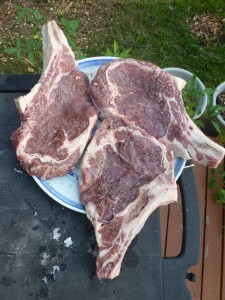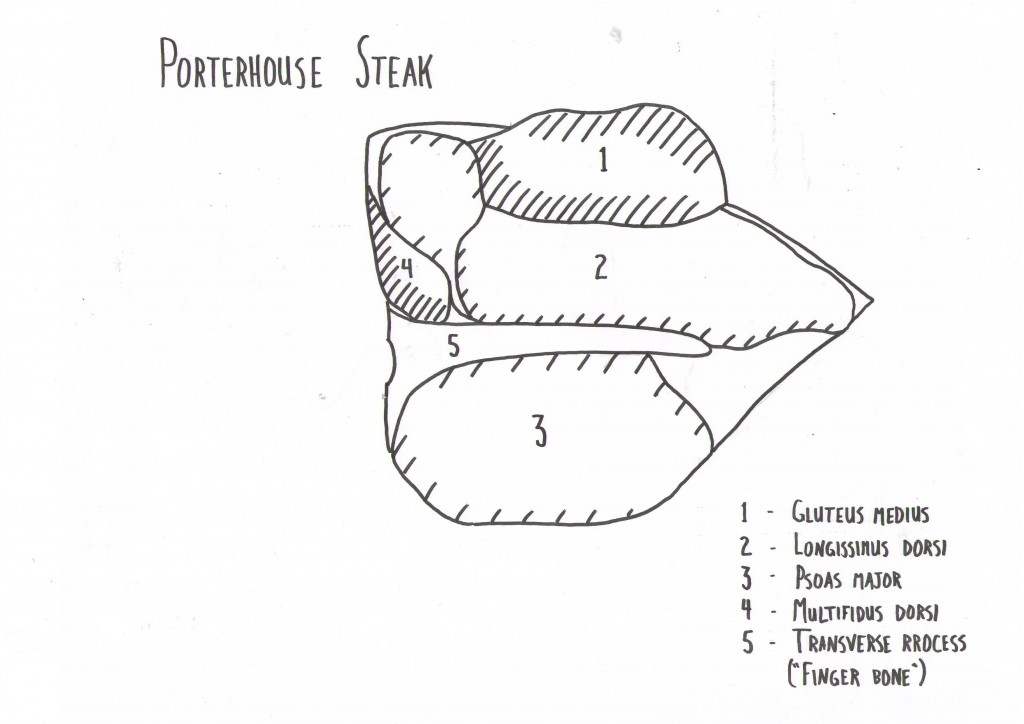 This post is about the most expensive cuts on a side of beef: the standing rib, the striploin, the tenderloin, and t-bone and porterhouse steaks.
This post is about the most expensive cuts on a side of beef: the standing rib, the striploin, the tenderloin, and t-bone and porterhouse steaks.
A Cow’s Skeletal Anatomy, Briefly…
The skull is connected to the neck, which connects to the backbone. At the front of the back bone are the shoulder bones that connect to the front legs. Farther down the backbone are the ribs. A cow has thirteen ribs. Backbones with ribs connected to them are called thoracic vertebrae. Between the rib cage and the hip is a section of backbone that has no ribs. These backbones are called lumbar vertebrae. Then there is the hip bone, which connects to the hind legs.
When a cow is killed, it is hung by its hind legs and eviscerated. Heart, lungs, liver, stomachs, intestines, bladder, kidneys, and lesser organs are all removed.
The carcass, which now consists only of meat, fat, and bones, is then cut in two symmetrical halves along the backbone. This exposes the brain and spinal cord and makes inspection and further processing easier. The two halves are called sides.
After some aging in a cooler, each side is split between the twelfth and thirteenth rib (which is the last rib…) into the forequarter and hindquarter.
Steaks from the Loin
The loin starts at the thirteenth rib, and follows the backbone to the hipbone. It is broken into two parts: the short loin and the sirloin. The sirloin is next to the hip. It makes familiar steaks, but they aren’t as tasty or expensive as those from the shortloin. The shortloin is made of two major and highly valuable muscles that run along the spine.
As mentioned earlier, the vertebrae between the rib cage and the hip bone do not have ribs, but they do have short bones poking out their sides, parallel to the longer rib bones farther up the spine. They connect the backbones to muscles and tendons, and are called finger bones (transverse processes in medical lingo). On a standing cow these bones project horizontally out from the vertebrae. The finger bones separate the two major, highly prized muscles in question. Above the finger bones sits the strip loin, and below them is the tenderloin.
The Strip Loin
longissimus dorsi
The strip loin has several known aliases. Generally, if the name of a steak contains any of the following words, it is from the strip loin: New York, Kansas, strip, or shell. The most common examples:
- strip loin steak
- New York steak
- New York strip steak
- Kansas City strip
- shell steak
They’re all the same. The major muscle of the strip loin steak, the longissimus dorsi, has an unmistakable, uniform oval shape. Usually there is a little fatty tail coming off the oval, where the loin is transitioning into the side of the cow. There’s also a nice fat cap.
Beef Tenderloin
psoas major
On the lower side of the finger bones runs the beef tenderloin. It’s roughly circular in cross-section. As it stretches towards the head of the cow it tapers. I call this part the tip. At the hind part the tenderloin gets wide and bulbous. I call this part the butt. In Britain the tenderloin is called the fillet. In Australia and New Zealand the eye fillet. In France and Germany the filet.
There is an extremely confusing set of words used to describe the different parts of the this cut. There are no less than three conflicting definitions for filet mignon (literally “little piece of filet”) in Larousse Gastronomique:
- “The filet mignon is a small, choice cut of meat from the end [tip] of the fillet.” (p. 483) This is the definition familiar to most gastronomes, and the one I was taught in culinary school.
- The filet mignon is a “piece of a small section of beef, positioned within the thoracic cage, along the first dorsal vertebrae.” (p. 482) This is really, really confusing. If you go back to our discussion of anatomical vernacular, you’ll see that this puts the tenderloin somewhere near where the neck meets the shoulders.
- Filet mignon is another word for tournedos, which is “a small round slice, about 1″ thick, taken from the heart of a fillet of beef and sautéed or grilled.” (p. 1227)
While the first definition is what I was taught in culinary school, the hugely disparate usage makes the word filet mignon completely useless. In restaurants in Edmonton, if you are served a filet mignon , you can be served a steak cut from any section of the tenderloin.
There is one more word associated with tenderloin. In restaurants in Edmonton, if you order a chateaubriand, you will usually get a section of tenderloin intended to serve two. From Larousse: “Chateaubriand [is] a slice of very tender fillet steak about 1 1/4 in thick. It is broiled or fried and often served with a sauce (traditionally béarnaise).” Absolutely no mention of it being served for two, nor which section of the tenderloin the steak is to come from.
As you can gather from the name, the tenderloin is an exceedingly tender cut of meat. However, it isn’t highly coveted by true beefeaters because it contains very little fat, is therefore not very flavourful, and offers little of the variety and interest of the porterhouse or rib steaks, as we will see shortly.
T-Bones and Porterhouse Steaks
longissimus dorsi, psoas major, and sometimes the gluteus medius
If the entire short loin is kept whole and then cut into steaks, you get slabs of meat that have a portion of striploin and a portion of tenderloin, separated by the finger bone. Depending on where exactly the steak is cut, this can be either a t-bone steak, or a porterhouse steak.
People have thought of all kinds of ways to define the difference between these two steaks. It’s actually pretty funny. Most agree that the t-bones are cut from the forward end of the short loin, while the porterhouses are from the back. Since the tenderloin tapers towards the front of the cow, t-bones therefore generally have smaller pieces of this muscle than the porterhouse. This, however, is not the defining characteristic of the steaks as butchers see it.
For a steak to be labelled a Porterhouse in Canada, it must have the tenderloin (psoas major), the striploin (longissimus dorsi), and another muscle called the gluteus medius (see diagram below). This is the difference between a porterhouse and a t-bone, as practice by professional meat-cutters in Canada.
In The Flavour Bible, Michael Lomonaco, the chef of Porter House New York, says that a porterhouse steak is a “double cut” T-bone steak.
We now leave the loin. Actually we will leave the hindquarter all together. From the loin, we are travelling up the backbone, towards the head of the cow. Ribs six through twelve define a section called the rib primal. If it still has all the bones in it, it’s called a standing rib. If the bones have been removed, it’s called the ribeye. This primal yields the most coveted of steaks, the rib steak.
Rib Steak
longissimus dorsi, longissimus costarum, spinalis dorsi
The rib section changes quite a bit over the distance between the sixth and twelfth rib. At the front, at the sixth rib, the rib primal is adjacent to the chuck primal. As such the rib primal is starting to break into the numerous, tough, interconnected muscles, with largish pockets of fat between, that we find in the chuck. The front two ribs of the rib primal are therefore not as desirable, which is why the five last ribs (ribs eight through twelve) are called the prime rib.
There several muscles in a rib steak. The largest is the longissimus dorsi, which farther back on the animal forms the striploin. Around this central muscle are a few others. Following the contour of the rib bone, and covered by a healthy amount of fat, is the longissimus costarum. At the top of the steak is a muscle called the spinalis dorsi, which is the most tender and flavourful part of the steak.
It just so happens that the very last ribs of the rib section, ribs eleven and twelve, have very little spinalis dorsi, so while they come at a premium price, they are not as enjoyable as the very central ribs.
For the record, then, the best steaks come from ribs eight, nine, and ten. Of course, when ordering in a restaurant you can’t usually make this specification. And the information certainly isn’t labelled on meats at the market. But the next time you buy a few rib steaks, compare them and try to discern where on the animal they came from.


